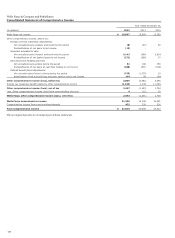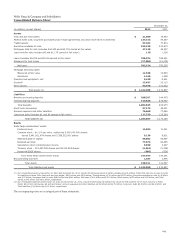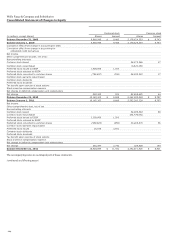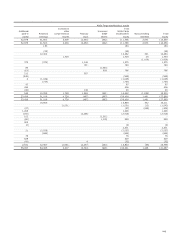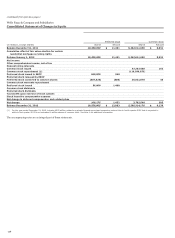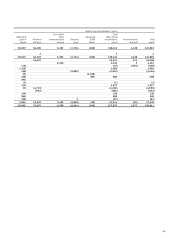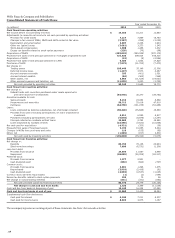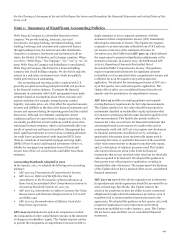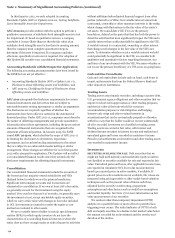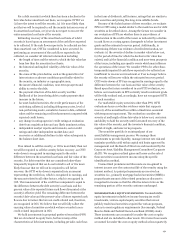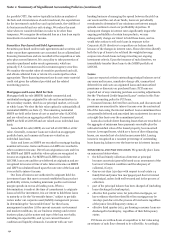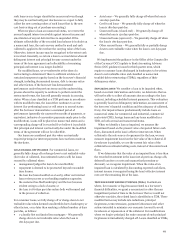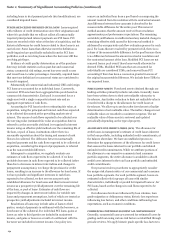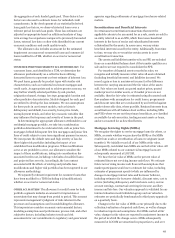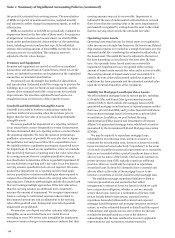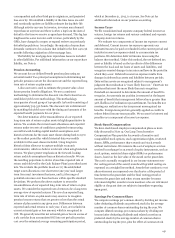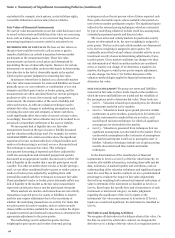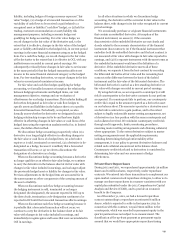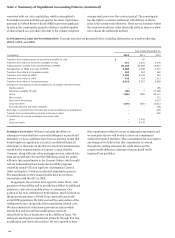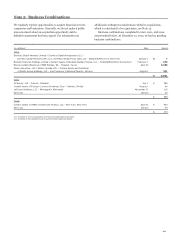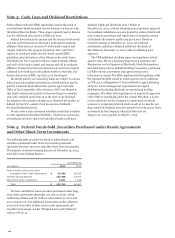Wells Fargo 2012 Annual Report Download - page 134
Download and view the complete annual report
Please find page 134 of the 2012 Wells Fargo annual report below. You can navigate through the pages in the report by either clicking on the pages listed below, or by using the keyword search tool below to find specific information within the annual report.Note 1: Summary of Significant Accounting Policies (continued)
for possible OTTI. Our review typically includes an analysis of
the facts and circumstances of each investment, the expectations
for the investment's cash flows and capital needs, the viability of
its business model and our exit strategy. We reduce the asset
value when we consider declines in value to be other than
temporary. We recognize the estimated loss as a loss from equity
investments in noninterest income.
Securities Purchased and Sold Agreements
Securities purchased under resale agreements and securities sold
under repurchase agreements are accounted for as collateralized
financing transactions and are recorded at the acquisition or sale
price plus accrued interest. It is our policy to take possession of
securities purchased under resale agreements, which are
primarily U.S. Government and Government agency securities.
We monitor the market value of securities purchased and sold,
and obtain collateral from or return it to counterparties when
appropriate. These financing transactions do not create material
credit risk given the collateral provided and the related
monitoring process.
Mortgages and Loans Held for Sale
Mortgages held for sale (MHFS) include commercial and
residential mortgages originated for sale and securitization in
the secondary market, which is our principal market, or for sale
as whole loans. We elect the fair value option for substantially all
residential MHFS (see Note 17). The remaining residential
MHFS are held at the lower of cost or market value (LOCOM),
and are valued on an aggregate portfolio basis. Commercial
MHFS are held at LOCOM and are valued on an individual loan
basis.
Loans held for sale (LHFS) are carried at LOCOM or at fair
value. Generally, consumer loans are valued on an aggregate
portfolio basis, and commercial loans are valued on an
individual loan basis.
Gains and losses on MHFS are recorded in mortgage banking
noninterest income. Gains and losses on LHFS are recorded in
other noninterest income. Direct loan origination costs and fees
for MHFS and LHFS under fair value option are recognized in
income at origination. For MHFS and LHFS recorded at
LOCOM, loan costs and fees are deferred at origination and are
recognized in income at time of sale. Interest income on MHFS
and LHFS is calculated based upon the note rate of the loan and
is recorded to interest income.
Our lines of business are authorized to originate held-for-
investment loans that meet or exceed established loan product
profitability criteria, including minimum positive net interest
margin spreads in excess of funding costs. When a
determination is made at the time of commitment to originate
loans as held for investment, it is our intent to hold these loans
to maturity or for the “foreseeable future,” subject to periodic
review under our corporate asset/liability management process.
In determining the “foreseeable future” for these loans,
management considers (1) the current economic environment
and market conditions, (2) our business strategy and current
business plans, (3) the nature and type of the loan receivable,
including its expected life, and (4) our current financial
condition and liquidity demands. Consistent with our core
banking business of managing the spread between the yield on
our assets and the cost of our funds, loans are periodically
reevaluated to determine if our minimum net interest margin
spreads continue to meet our profitability objectives. If
subsequent changes in interest rates significantly impact the
ongoing profitability of certain loan products, we may
subsequently change our intent to hold these loans, and we
would take actions to sell such loans in response to the
Corporate ALCO directives to reposition our balance sheet
because of the changes in interest rates. These directives identify
both the type of loans to be sold and the weighted average
coupon rate of such loans no longer meeting our ongoing
investment criteria. Upon the issuance of such directives, we
immediately transfer these loans to the MHFS portfolio at
LOCOM.
Loans
Loans are reported at their outstanding principal balances net of
any unearned income, cumulative charge-offs, unamortized
deferred fees and costs on originated loans and unamortized
premiums or discounts on purchased loans. PCI loans are
reported net of any remaining purchase accounting adjustments.
See the “Purchased Credit-Impaired Loans” section in this Note
for our accounting policy for PCI loans.
Unearned income, deferred fees and costs, and discounts and
premiums are amortized to interest income over the contractual
life of the loan using the interest method. Loan commitment fees
are generally deferred and amortized into noninterest income on
a straight-line basis over the commitment period.
Loans also include direct financing leases that are recorded at
the aggregate of minimum lease payments receivable plus the
estimated residual value of the leased property, less unearned
income. Leveraged leases, which are a form of direct financing
leases, are recorded net of related nonrecourse debt. Leasing
income is recognized as a constant percentage of outstanding
lease financing balances over the lease terms in interest income.
NONACCRUAL AND PAST DUE LOANS We generally place loans
on nonaccrual status when:
x the full and timely collection of interest or principal
becomes uncertain (generally based on an assessment of the
borrower’s financial condition and the adequacy of
collateral, if any);
x they are 90 days (120 days with respect to real estate 1-4
family first and junior lien mortgages) past due for interest
or principal, unless both well-secured and in the process of
collection;
x part of the principal balance has been charged off (including
loans discharged in bankruptcy);
x effective first quarter 2012, for junior lien mortgages, we
have evidence that the related first lien mortgage may be
120 days past due or in the process of foreclosure regardless
of the junior lien delinquency status; or
x effective third quarter 2012, performing consumer loans are
discharged in bankruptcy, regardless of their delinquency
status.
PCI loans are written down at acquisition to fair value using
an estimate of cash flows deemed to be collectible. Accordingly,
132


